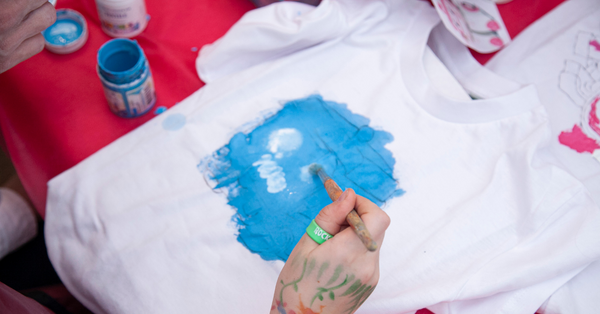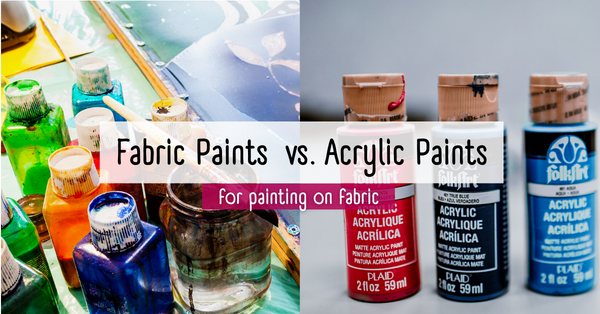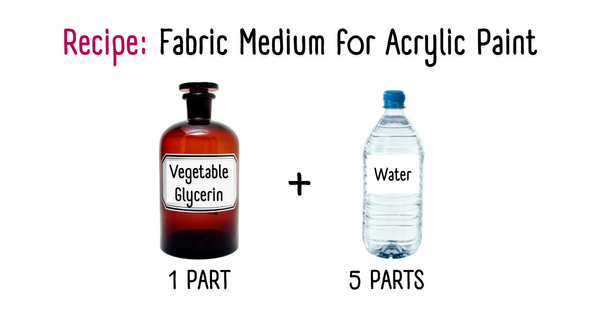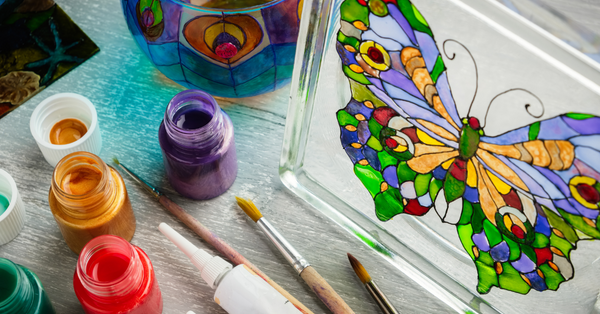
Did you know you can use acrylic paint on fabric instead of traditional fabric paint or dyes and still have a beautiful, professional-looking painted t-shirt or shoe? That’s right! Your acrylic paint laying around the house doesn’t have to go to waste, and in fact, there are some situations where acrylic paint might even be the better choice.
Acrylic paint is flexible, durable, and inexpensive, making it great for all types of art projects. And you probably already have some of it laying around. So, why not put it to good use and give those white sneakers a nice pop of color?
But, there are a few things to take into consideration before you jump right in, and you might need a few other materials to get started.
We’ll go over exactly what you’ll need and how to get started with acrylic fabric painting. Plus, we’ll discuss why you would pick one over the other, along with the pros and cons of each medium.
TABLE OF CONTENTS
- Fabric vs Acrylic Paint
- Getting Started with Acrylic Paints on Fabric
- Painting Fabric with Acrylics – A Step by Step Guide
Fabric vs Acrylic Paint

Fabric paints
Fabric paint, as the name implies, was created specifically for use on fabrics. In essence, it is fabric dye combined with a binding agent to make it stick. Therefore, you won’t need to pre-mix it with a medium, but you will need to seal the paint with heat if you plan to wash the finished product. Ultimately, it’s very safe and easy to use.
This FolkArt Brush-on Fabric Paint Set is a great, affordable set of fabric paints for beginners.
However, fabric paint does have one major drawback – it cannot be used on synthetic fibers as it won’t bind well. So while fabric paint is great to use on natural fibers, it cannot be used on all types of fabric and textile materials, limiting it for use when compared with something like acrylic paint.
Acrylic paints
On the other hand, acrylic paint can be used on all types of fabrics without limitation. It is a water-soluble paint that dries quickly to be water-resistant. It’s durable, long-lasting, and inexpensive. Acrylic paint is sold in almost every color you can think of and leaves a bright, vibrant finish, making it great for use on things like t-shirts and shoes.
If you’re interested in working with acrylics, we recommend the Arteza Acrylic Paint set which comes with 24 different colors and is great for beginners.
Why you need a fabric medium to use acrylic paint on fabric
Keep in mind though, acrylic paint requires a few additional steps that fabric paint does not. To start, acrylic paint will not bind naturally to fibers, so you’ll have to mix your acrylic paint with a medium before applying it to fabrics. This allows it to bind to the material without leaving a hard, inflexible surface after drying.
If you skip this step, your acrylic paint may begin to crack and flake off after it dries. Like fabric paint, you’ll still need to heat set acrylics on fabrics to allow for washing and general longevity and durability.
So which is better: Fabric or Acrylic Paint?
Ultimately, you can use acrylic paint mixed with a medium on any fabric surface for a beautiful and durable finished project. It will save you money and can provide more vibrant and diverse color options. However, fabric paint is just as effective when used with natural fibers and doesn’t require being mixed with a medium first.
Getting Started with Acrylic Paints on Fabrics
Now that you understand the primary differences between acrylic and fabric paints, you might be ready to move forward with trying out acrylic paints on fabrics for the first time. First, you’ll want to select your acrylic paint as well as a fabric medium.
Choosing an acrylic paint for fabric
Almost any type of acrylic paint will work on fabric, so long as it’s combined with a medium first. The only type of acrylic to avoid is anything labeled ‘washable’ or ‘non-permanent’ as these paints will easily flake off in the washing machine. Otherwise, whatever you find at the local art store or have laying around at the house will do just fine.

Choosing a fabric medium
As for a fabric medium, you have a couple of options. You can, of course, head to your local art store and purchase an acrylic paint fabric medium. We recommend the Delta Fabric Medium, which can be used with any brand of acrylic paint. Plus, it’s sold on Amazon and is very wallet-friendly – you can’t beat that.
Alternatively, you might choose to make your own fabric medium at home. All you’ll need to do is mix water with vegetable glycerin in a 5:1 ratio. Vegetable glycerin is really cheap and sold at most pharmacies. Both homemade and store bought options will get the job done!

The only time you would want to skip using a fabric medium is if you plan to paint fabric that will only be on display.
Without a medium, acrylic paint will dry very hard and inflexible, making it less than ideal for clothing like t-shirts or pants. However, the acrylic paint will last longer and be more durable without a medium, making it ideal for fabrics on display. In sum, you shouldn’t wash acrylic paint on fabric unless you use a medium during application.
Painting Fabric with Acrylics – A Step by Step Guide
Once you’ve selected your acrylic paint and fabric medium, follow these simple steps to create a fun and functional piece of fabric art:
Gather your materials
You’ll need the following materials:
- Acrylic paint
- Fabric medium
- Fabric to be painted (more on this in the next step)
- Paint brushes
- Paper towels
- Cups of water for rinsing brushes
- Cardboard (specifically for painting thinner t-shirts)
- Iron, oven, or dryer for heat setting
Choose & Prepare Your Fabric
While it’s true you can paint almost any type of fabric with acrylic paint, you should take a few things into consideration when selecting your piece. Try to opt for a light colored, smooth textured piece of fabric.

The best materials for painting include cotton, silk, velvet, and polyester. That being said, you can still apply paint to darker or rougher materials, it just might take a little more time and paint.
Either way, you’ll want to wash your fabric to reduce shrinking after the paint has been applied and iron it out to get rid of any wrinkles.
Consider putting a piece of cardboard inside to reduce the chance of paint bleeding through to the other side.
Mix Your Paint & Medium

Next, you’ll want to prepare the paint mixture.
If you went with a store-bought option, follow the directions on the bottle. If you chose to go with a homemade version, you’ll want to do a 1:1 mixture of fabric medium and acrylic paint.
You can always add more fabric medium if you feel the mixture is too thick and not sticking well.
Apply Paint to Your Fabric

This is where you can get creative!
Apply the acrylic paint and fabric medium mixture to your fabric in layers, as necessary.
You can use stencils to help achieve a certain look or design, or you can go old school and free-hand it.
Either way, have fun and let the creative juices flow!
If you need to make layers, allow each layer to dry before applying more paint to avoid unwanted blending.
Seal Your Acrylic Paint
Once your paint has dried completely, you’ll want to heat set the final product to improve longevity and durability.

Add a pressing cloth to the top of your painted design and gently iron over the cloth with a dry iron. Keep your iron moving the whole time to avoid burning the fabric or the artwork. The heat will press the design into the fabric, allowing for wearing and washing.
While the iron method is the most tried and true, you can also heat set your fabric in the oven or by using your dryer.
If using your oven, don’t set the temperature above 250 and only leave it in the oven for a few minutes.
If you opt for the dryer method, place your fabric in the dryer on medium-high heat for 45-50 minutes.
Key takeaway
Overall, acrylic paint mixed with a fabric medium is a safe and effective way to add some vibrance to your next fabric painting project.
While fabric paint may seem like the best way to go, these products are not meant to be used on synthetic materials and won’t always give the same variety or effervescence in terms of color.
So, put those extra acrylics to use and give your old t-shirt a makeover!




